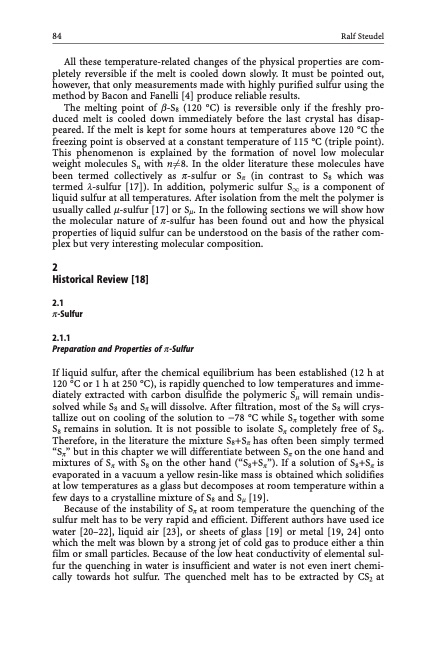
PDF Publication Title:
Text from PDF Page: 094
84 Ralf Steudel All these temperature-related changes of the physical properties are com- pletely reversible if the melt is cooled down slowly. It must be pointed out, however, that only measurements made with highly purified sulfur using the method by Bacon and Fanelli [4] produce reliable results. The melting point of b-S8 (120 C) is reversible only if the freshly pro- duced melt is cooled down immediately before the last crystal has disap- peared. If the melt is kept for some hours at temperatures above 120 C the freezing point is observed at a constant temperature of 115 C (triple point). This phenomenon is explained by the formation of novel low molecular weight molecules Sn with n61⁄48. In the older literature these molecules have been termed collectively as p-sulfur or Sp (in contrast to S8 which was termed l-sulfur [17]). In addition, polymeric sulfur S1 is a component of liquid sulfur at all temperatures. After isolation from the melt the polymer is usually called m-sulfur [17] or Sm. In the following sections we will show how the molecular nature of p-sulfur has been found out and how the physical properties of liquid sulfur can be understood on the basis of the rather com- plex but very interesting molecular composition. 2 Historical Review [18] 2.1 p-Sulfur 2.1.1 Preparation and Properties of p-Sulfur If liquid sulfur, after the chemical equilibrium has been established (12 h at 120 C or 1 h at 250 C), is rapidly quenched to low temperatures and imme- diately extracted with carbon disulfide the polymeric Sm will remain undis- solved while S8 and Sp will dissolve. After filtration, most of the S8 will crys- tallize out on cooling of the solution to 78 C while Sp together with some S8 remains in solution. It is not possible to isolate Sp completely free of S8. Therefore, in the literature the mixture S8+Sp has often been simply termed “Sp” but in this chapter we will differentiate between Sp on the one hand and mixtures of Sp with S8 on the other hand (“S8+Sp”). If a solution of S8+Sp is evaporated in a vacuum a yellow resin-like mass is obtained which solidifies at low temperatures as a glass but decomposes at room temperature within a few days to a crystalline mixture of S8 and Sm [19]. Because of the instability of Sp at room temperature the quenching of the sulfur melt has to be very rapid and efficient. Different authors have used ice water [20–22], liquid air [23], or sheets of glass [19] or metal [19, 24] onto which the melt was blown by a strong jet of cold gas to produce either a thin film or small particles. Because of the low heat conductivity of elemental sul- fur the quenching in water is insufficient and water is not even inert chemi- cally towards hot sulfur. The quenched melt has to be extracted by CS2 atPDF Image | Topics in Current Chemistry

PDF Search Title:
Topics in Current ChemistryOriginal File Name Searched:
Elemental-Sulfur-und-Sulfur-Rich-Compounds-I.pdfDIY PDF Search: Google It | Yahoo | Bing
Sulfur Deposition on Carbon Nanofibers using Supercritical CO2 Sulfur Deposition on Carbon Nanofibers using Supercritical CO2. Gamma sulfur also known as mother of pearl sulfur and nacreous sulfur... More Info
CO2 Organic Rankine Cycle Experimenter Platform The supercritical CO2 phase change system is both a heat pump and organic rankine cycle which can be used for those purposes and as a supercritical extractor for advanced subcritical and supercritical extraction technology. Uses include producing nanoparticles, precious metal CO2 extraction, lithium battery recycling, and other applications... More Info
| CONTACT TEL: 608-238-6001 Email: greg@infinityturbine.com | RSS | AMP |